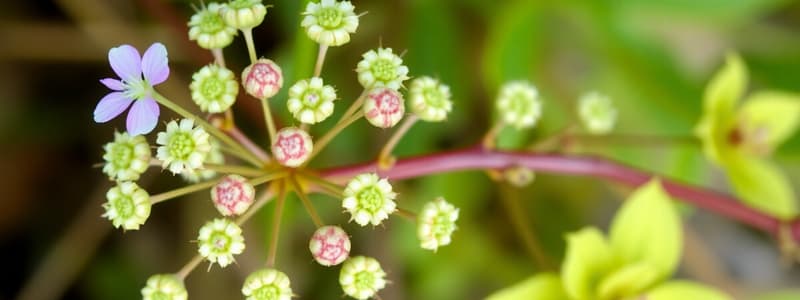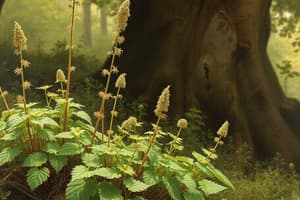Podcast
Questions and Answers
What type of organism are all plants classified as?
What type of organism are all plants classified as?
- Multicellular producers (correct)
- Unicellular consumers
- Eukaryotic heterotrophs
- Multicellular decomposers
Which of the following statements about vascular tissue is true?
Which of the following statements about vascular tissue is true?
- It is only present in nonvascular plants.
- It transports only water throughout the plant.
- It consists of unicellular structures.
- It is made up of xylem and phloem. (correct)
What is the primary process through which plants produce their own food?
What is the primary process through which plants produce their own food?
- Cellular respiration
- Decomposition
- Fermentation
- Photosynthesis (correct)
What is the primary method of reproduction for nonvascular plants?
What is the primary method of reproduction for nonvascular plants?
Which characteristic distinguishes plants from other life forms?
Which characteristic distinguishes plants from other life forms?
What are spores capable of in relation to environmental conditions?
What are spores capable of in relation to environmental conditions?
Which of the following correctly describes the nature of plant DNA?
Which of the following correctly describes the nature of plant DNA?
Which of the following statements about spores is true?
Which of the following statements about spores is true?
In the spore reproduction cycle of nonvascular plants, what role do spores play?
In the spore reproduction cycle of nonvascular plants, what role do spores play?
What distinguishes nonvascular plants from vascular plants?
What distinguishes nonvascular plants from vascular plants?
What prevents nonvascular plants from growing large?
What prevents nonvascular plants from growing large?
Why is it challenging for nonvascular plants to obtain nutrients?
Why is it challenging for nonvascular plants to obtain nutrients?
In what type of environment do nonvascular plants typically thrive?
In what type of environment do nonvascular plants typically thrive?
What would happen if nonvascular plants were large?
What would happen if nonvascular plants were large?
How do nonvascular plants transport materials within themselves?
How do nonvascular plants transport materials within themselves?
Which structure is responsible for the circulation of food and water in vascular plants?
Which structure is responsible for the circulation of food and water in vascular plants?
What is a characteristic feature of nonvascular plants?
What is a characteristic feature of nonvascular plants?
Which of the following is an example of a vascular plant?
Which of the following is an example of a vascular plant?
Nonvascular plants are primarily characterized by which of the following traits?
Nonvascular plants are primarily characterized by which of the following traits?
Which of these characteristics does not apply to vascular plants?
Which of these characteristics does not apply to vascular plants?
What is the primary characteristic of kinetic energy?
What is the primary characteristic of kinetic energy?
Which of the following factors does NOT affect kinetic energy?
Which of the following factors does NOT affect kinetic energy?
If the mass of an object is doubled while keeping its speed constant, what happens to its kinetic energy?
If the mass of an object is doubled while keeping its speed constant, what happens to its kinetic energy?
Which of the following examples illustrates kinetic energy?
Which of the following examples illustrates kinetic energy?
What is elastic potential energy primarily associated with?
What is elastic potential energy primarily associated with?
What happens to the kinetic energy of an object as its speed increases?
What happens to the kinetic energy of an object as its speed increases?
Which factor does NOT influence chemical potential energy?
Which factor does NOT influence chemical potential energy?
As an elastic material is stretched, what happens to its elastic potential energy?
As an elastic material is stretched, what happens to its elastic potential energy?
Which of the following is a common source of chemical potential energy?
Which of the following is a common source of chemical potential energy?
Which statement is true regarding chemical potential energy?
Which statement is true regarding chemical potential energy?
What type of energy is defined as the energy an object has due to its position?
What type of energy is defined as the energy an object has due to its position?
What factors determine gravitational potential energy?
What factors determine gravitational potential energy?
Can an object possess both kinetic and potential energy simultaneously?
Can an object possess both kinetic and potential energy simultaneously?
Which of the following best describes gravitational potential energy?
Which of the following best describes gravitational potential energy?
What is a common example of an object possessing both kinetic and potential energy?
What is a common example of an object possessing both kinetic and potential energy?
Flashcards
Plant Multicellularity
Plant Multicellularity
Plants are made of many cells working together.
Plant Producers
Plant Producers
Plants make their own food through photosynthesis.
Photosynthesis Equation
Photosynthesis Equation
Carbon dioxide + water + sunlight → sugar + oxygen
Plant Eukaryotic Cells
Plant Eukaryotic Cells
Signup and view all the flashcards
Vascular Plants
Vascular Plants
Signup and view all the flashcards
Nonvascular plant size limit
Nonvascular plant size limit
Signup and view all the flashcards
Nonvascular plant habitat
Nonvascular plant habitat
Signup and view all the flashcards
Transport system in plants
Transport system in plants
Signup and view all the flashcards
Nutrient uptake in nonvascular plants
Nutrient uptake in nonvascular plants
Signup and view all the flashcards
Why are nonvascular plants small?
Why are nonvascular plants small?
Signup and view all the flashcards
Spores
Spores
Signup and view all the flashcards
Spore Reproduction
Spore Reproduction
Signup and view all the flashcards
What makes spores unique?
What makes spores unique?
Signup and view all the flashcards
How do nonvascular plants reproduce?
How do nonvascular plants reproduce?
Signup and view all the flashcards
Nonvascular Plant
Nonvascular Plant
Signup and view all the flashcards
Seedless Plant
Seedless Plant
Signup and view all the flashcards
Xylem
Xylem
Signup and view all the flashcards
Phloem
Phloem
Signup and view all the flashcards
Potential Energy
Potential Energy
Signup and view all the flashcards
Gravitational Potential Energy
Gravitational Potential Energy
Signup and view all the flashcards
Can objects have both potential and kinetic energy?
Can objects have both potential and kinetic energy?
Signup and view all the flashcards
What affects gravitational potential energy?
What affects gravitational potential energy?
Signup and view all the flashcards
Example of Potential & Kinetic Energy
Example of Potential & Kinetic Energy
Signup and view all the flashcards
Elastic Potential Energy
Elastic Potential Energy
Signup and view all the flashcards
What is the relationship between elastic potential energy and stretch?
What is the relationship between elastic potential energy and stretch?
Signup and view all the flashcards
Chemical Potential Energy
Chemical Potential Energy
Signup and view all the flashcards
Where is chemical potential energy stored?
Where is chemical potential energy stored?
Signup and view all the flashcards
Examples of chemical potential energy sources
Examples of chemical potential energy sources
Signup and view all the flashcards
Energy
Energy
Signup and view all the flashcards
Kinetic Energy
Kinetic Energy
Signup and view all the flashcards
What affects kinetic energy?
What affects kinetic energy?
Signup and view all the flashcards
Types of Energy
Types of Energy
Signup and view all the flashcards




